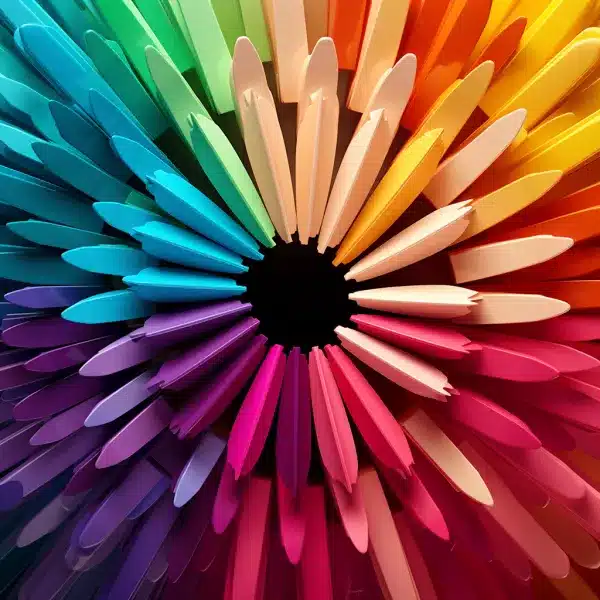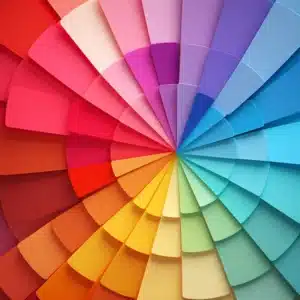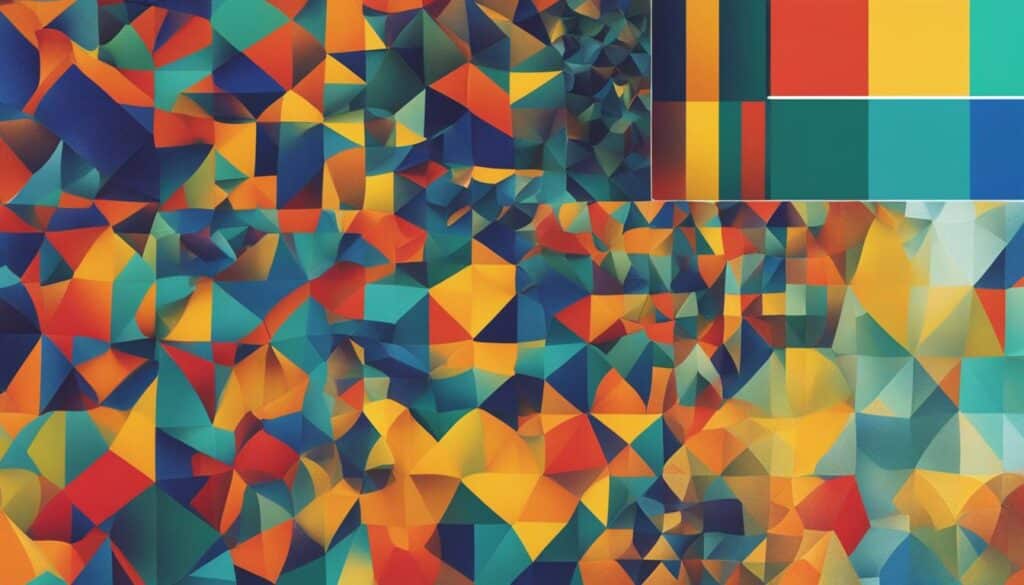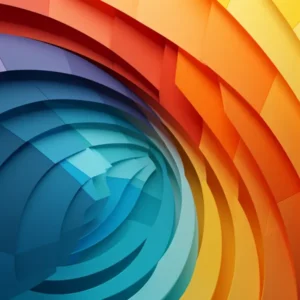
As a web designer, I understand the importance of creating visually captivating and engaging websites. One crucial element that often gets overlooked is the use of color in web design. By incorporating color psychology into our designs, we can significantly enhance the user experience and create websites that leave a lasting impression.
Color psychology, the study of how colors affect human emotions and behaviors, provides valuable insights into the impact colors have on website visitors. By strategically selecting and implementing colors, we can evoke specific emotions, guide user behavior, and establish a strong connection with our audience.
Key Takeaways:
- Understanding the psychological impact of colors is essential for creating effective websites.
- Colors have the power to evoke emotions and shape user behavior.
- Choosing the right color scheme sets the tone and conveys the desired message.
- Consider the brand and target audience when selecting colors for web design.
- By leveraging color psychology, designers can unlock the full potential of their websites.

Understanding Color Psychology in Web Design
Color psychology is a powerful tool that web designers can harness to create visually appealing and impactful websites. By understanding how colors evoke emotions and influence behavior, designers can strategically use colors to enhance the overall user experience. The psychology of colors in web design is rooted in the understanding that different colors elicit specific responses from users.
Warm colors, like orange and red, are known to make people feel tense and rushed. You can use these colors to get people's attention and get them to take action. Cool colors, like blue and green, on the other hand, can help you feel calm and trusting. By choosing the right colors, designers can get people to feel the way they want them to.
Color theory in web design plays a crucial role in the choice of color schemes. Different color combinations create varying psychological impacts. For instance, a monochromatic color scheme can create a harmonious and balanced look, while complementary colors create contrast and draw attention. Designers can also experiment with analogous and triadic color schemes to achieve a cohesive and visually appealing website design.
By understanding and incorporating color psychology in web design, designers can create websites that resonate with users on a deep emotional level. The strategic use of colors can evoke specific emotions, guide user behavior, and shape the overall user experience. With a well-thought-out color scheme, designers can effectively convey their message and create a visually engaging website that leaves a lasting impact on visitors.
Table: Psychological Effects of Different Colors in Web Design
| Color | Psychological Effect |
|---|---|
| Red | Elicits excitement and urgency, grabs attention |
| Orange | Creates a sense of energy and enthusiasm |
| Yellow | Induces feelings of happiness and optimism |
| Green | Symbolizes nature, promotes relaxation and trust |
| Blue | Creates a sense of calmness and stability |
| Purple | Represents creativity and luxury |
Effective Color Schemes in Web Design
Color design is crucial to website mood. Different color combinations evoke different emotions. Monochromatic plans look balanced when using multiple tones of the same color. Colors opposite one other on the color wheel are complimentary. They draw attention. A area feels connected when hues close to one other on the color wheel are similar. A lively and appealing color combination is created when three hues are appropriately distributed throughout the color wheel. By adopting the proper color scheme, designers can create websites that engage consumers and communicate clearly.
When choosing a color scheme, consider the brand's personality and target audience. Colors have meanings and evoke distinct emotions. For example, blue symbolizes dependability and trust, whereas red represents excitement and urgency. For a brand's visual identity to attract the proper people, designers must match the color scheme to its personality and ideals.
The Impact of Colors in Web Design
Colors have a profound impact on users' perception and behavior. Understanding the psychology behind colors can help designers strategically use them to achieve specific goals. For instance, warm colors like red, orange, and yellow can create a sense of urgency and encourage action. On the other hand, cool colors like blue and green evoke a feeling of calmness and relaxation.
- Monochromatic Color Scheme:
- Complementary Color Scheme:
- Analogous Color Scheme:
- Triadic Color Scheme:
A monochromatic color scheme is created by using different shades, tints, and tones of a single color. This scheme is visually pleasing and creates a sense of harmony. Complementary colors, such as blue and orange, create contrast and make elements stand out. Analogous colors, like blue, green, and turquoise, work well together and create a sense of unity. Triadic color schemes, consisting of three colors equally spaced on the color wheel, create a dynamic and visually appealing combination.
| Color Scheme | Description | Example |
|---|---|---|
| Monochromatic | Uses variations of a single color |  |
| Complementary | Uses colors opposite each other on the color wheel | |
| Analogous | Uses colors adjacent on the color wheel |  |
| Triadic | Uses three colors evenly spaced on the color wheel |
By understanding the impact of different color schemes and selecting the right one for a website, designers can create visually appealing and effective designs that resonate with users. The color scheme should align with the brand's message and target audience, evoking the desired emotions and creating a memorable user experience.

Conclusion
Incorporating color psychology into web design is a powerful technique for creating effective websites. Colors have the ability to evoke emotions, guide user behavior, and shape the overall user experience. By understanding the psychological impact of colors and using them strategically, designers can create visually appealing websites that engage users on an emotional level.
When picking a color scheme, it's important to think about the feelings and messages that the brand and its viewers want to convey. Different color combinations make people feel different things. A one-color design looks balanced and harmonious, while colors that go well together stand out and draw attention to themselves. Triadic colors make a combination that is dynamic and visually appealing, while analogous colors make a combination that feels united and unified.
By harnessing the power of color in web design, designers can unlock the full potential of their websites. Colors not only enhance the visual appeal but also play a crucial role in conveying messages and creating connections with visitors. The impact of color in web design cannot be underestimated, as it has a profound influence on user perception and engagement. When used strategically and in line with the brand's identity, colors can evoke desired emotions and lead to a positive user experience.
FAQ
How does color psychology impact web design?
Color psychology in web design explores the impact that colors have on people's emotions and behavior. By strategically using colors, designers can elicit specific responses from visitors and enhance their overall experience.
What are some examples of warm colors and their effects?
Warm colors like red and orange can create a sense of excitement and urgency, making them suitable for calls-to-action or highlighting important elements on a website.
What about cool colors?
Cool colors like blue and green induce calmness and are often used in websites that want to create a sense of tranquility or convey a feeling of trustworthiness.
How does the choice of color scheme impact web design?
Different color combinations have varying psychological impacts. A monochromatic scheme creates a harmonious and balanced look, while complementary colors create contrast and draw attention. Analogous colors create a cohesive and unified feel, and triadic colors create a dynamic and visually appealing combination.
How can color psychology be incorporated into web design?
By understanding the psychological impact of colors and using them strategically, designers can create visually appealing websites that engage users on an emotional level. It's important to consider the specific emotions and messages that align with the brand and target audience when choosing a color scheme.
Why is color important in web design?
Colors have the ability to evoke emotions, guide user behavior, and shape the overall user experience. By harnessing the power of color, designers can unlock the full potential of their websites and create effective platforms for their brand.











